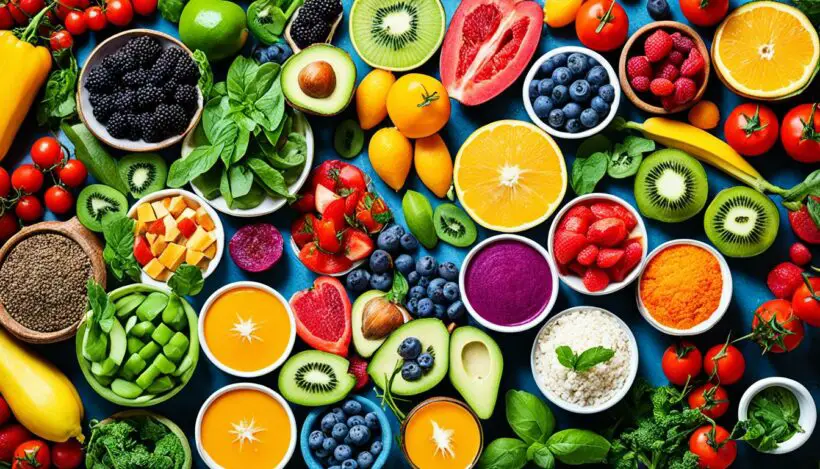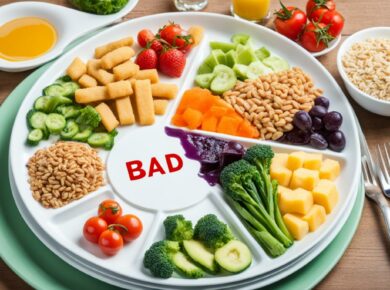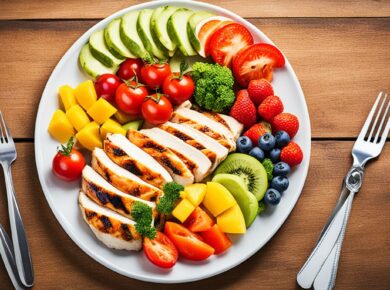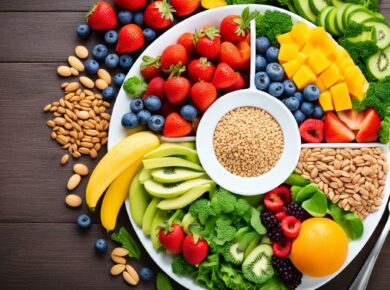Welcome to our article on choosing nutrient-dense alternatives for a healthier lifestyle. In today’s fast-paced world, it’s important to prioritize our health and make conscious choices when it comes to our food. By opting for nutrient-dense alternatives, we can enhance our diet and boost our overall well-being. In this article, we will explore the concept of nutrient density and provide you with practical tips on incorporating nutrient-rich substitutes into your daily meals.
At times, making healthy food swaps may seem daunting, but with a little knowledge and creativity, it can be both enjoyable and beneficial. By focusing on nutrient-dense ingredients, you can nourish your body with essential vitamins, minerals, and other vital nutrients, while reducing your intake of unhealthy saturated fats, added sugars, and sodium.
So, are you ready to embark on a journey towards a nutrient-rich diet? Join us as we explore what nutrient density means, how to add nutrient-dense foods to your eating plan, the importance of choosing nutrient-rich snacks, the role of nutrient-rich foods in healthy aging, and the key food groups for a nutrient-rich diet. We will also provide you with guidance on making wise choices and limiting added sugars and unhealthy fats.
Let’s dive in and discover the incredible benefits of nutrient-dense alternatives for your health and well-being!
What Does Nutrient Dense Mean?
Nutrient density refers to the amount of nutrients you get from a food in relation to the calories it provides. When we talk about nutrient-dense foods, we are referring to those that are packed with vitamins, minerals, and other essential nutrients while having a lower calorie content. These foods offer a high nutritional value per calorie consumed, making them an excellent choice for optimal health and wellness.
On the other hand, foods that provide empty calories are high in calories but offer little nutritional value. These foods contribute to an energy-rich but nutrient-poor diet, which can have negative impacts on our overall health and well-being. Consuming too many empty calories can lead to weight gain, nutrient deficiencies, and an increased risk of chronic diseases.
To make wise decisions about the foods we eat, it’s essential to understand the concept of nutrient density. By choosing nutrient-dense alternatives, we can ensure that our bodies receive the essential vitamins, minerals, and nutrients they need to function properly. These foods provide us with the energy we need while also supplying our bodies with the necessary building blocks for optimal health.
When we incorporate nutrient-dense foods into our diet, we nourish our bodies and support various bodily functions. These foods support the immune system, promote healthy digestion, strengthen bones, enhance cognitive function, and contribute to overall well-being. By prioritizing nutrient-dense options, we can boost our energy levels, improve our mood, and ensure that our bodies receive the vital nutrients they need to thrive.
How to Add Nutrient-Dense Foods to Your Healthy Eating Plan
Adding nutrient-dense foods to your diet doesn’t have to be complicated. Simple swaps and additions can make a big difference. Here are some tips to help you increase the nutrient density of your meals and snacks:
- Replace refined grains with whole grains like whole-wheat bread and brown rice. Whole grains are rich in fiber, vitamins, and minerals, providing more nutrients compared to their refined counterparts.
- Increase your intake of fruits and vegetables, aiming for a variety of colors. Fruits and vegetables are packed with essential vitamins, minerals, and antioxidants that promote good health.
- Choose healthy protein sources such as lean meats, fish, legumes, and nuts. These options are not only rich in protein but also provide important nutrients like omega-3 fatty acids, iron, and zinc.
- Incorporate nuts and seeds into your meals and snacks. They are a great source of healthy fats, fiber, and various micronutrients.
- Don’t forget legumes! Beans, lentils, and chickpeas are not only economical but also high in fiber, protein, and minerals.
By making these simple changes, you can easily boost the nutrient density of your diet. Remember to choose a variety of whole grains, fruits, vegetables, healthy protein sources, nuts, and legumes to ensure you’re getting a wide range of essential nutrients.
And here’s an image of a delicious and nutritious salad to inspire you:
Snack on Nutrient-Dense Foods
Snacks play a significant role in our daily calorie intake. However, traditional snack foods like chips and cookies often lack the essential nutrients our bodies need. Instead, opt for healthy, nutrient-dense snacks that provide the nourishment you crave.
When it comes to snacking, fruits and vegetables are excellent choices. Packed with vitamins, minerals, and fiber, they offer a refreshing and nutrient-rich option. Enjoy a variety of colorful fruits, such as berries, apples, and citrus fruits, for a natural sweetness that satisfies your cravings. For a crunchy and wholesome snack, slice up some cucumbers, bell peppers, or baby carrots and pair them with a yogurt-based dip.
Another great option is unsalted nuts. Almonds, walnuts, and cashews are all packed with healthy fats, protein, and fiber, making them a filling and nutrient-dense choice. Just remember to opt for unsalted varieties to keep your sodium intake in check.
Hydration is also an essential part of a healthy snacking routine. Instead of reaching for sugary drinks, quench your thirst with infused water or unsweetened tea. Infuse your water with slices of citrus fruits, cucumbers, or mint leaves for added flavor.
By incorporating nutrient-dense snacks into your daily routine, you can satisfy your hunger, boost your energy, and prioritize your health. Choose fruits, vegetables, unsalted nuts, and hydrating beverages to create a snack plan that nourishes your body from within.
Importance of Nutrient-Rich Foods for Healthy Aging
As you age, it becomes even more crucial to prioritize nutrient-rich foods in your diet. These foods are packed with essential vitamins and minerals that support your overall health and help reduce the risk of chronic diseases, allowing for healthy aging. Including nutrient-rich foods as the foundation of your meals is key to maintaining strong bones and optimal health as you grow older.
Nutrient-rich foods include a wide variety of options such as fruits, vegetables, lean meats, seafood, whole grains, and dairy products. These foods provide a multitude of vitamins and minerals that are essential for bodily functions and overall well-being. By consuming an adequate intake of nutrients, you can support your body’s vital processes and promote healthy aging.
One of the primary benefits of nutrient-rich foods is their ability to reduce the risk of chronic diseases. By incorporating a variety of fruits and vegetables into your meals, you can take advantage of their potent antioxidant properties, which help combat inflammation and oxidative stress in the body. Additionally, lean meats, seafood, and dairy products offer valuable protein, vitamins, and minerals that support cellular function and contribute to healthy aging.
The Role of Nutrient-Rich Foods in Healthy Aging
Nutrient-rich foods play a vital role in healthy aging by providing the necessary nutrients for optimal function and preventing deficiencies. Here are some key benefits of including nutrient-rich foods in your diet:
- Supports overall health: Nutrient-rich foods supply your body with the vitamins, minerals, and other essential nutrients it needs to function at its best, promoting overall health and well-being.
- Reduces the risk of chronic diseases: By consuming nutrient-rich foods, you can lower your risk of developing chronic diseases such as heart disease, diabetes, and certain types of cancer. The abundance of antioxidants, fiber, and other beneficial compounds found in these foods help protect against these diseases.
- Maintains strong bones: Adequate intake of nutrients like calcium and vitamin D through nutrient-rich foods is important for maintaining strong and healthy bones, reducing the risk of osteoporosis and fractures.
- Supports brain health: Nutrient-rich foods, especially those rich in omega-3 fatty acids, such as fatty fish and walnuts, are known to support brain health and cognitive function, reducing the risk of age-related cognitive decline.
- Promotes healthy digestion: Many nutrient-rich foods, such as fruits, vegetables, and whole grains, are rich in fiber, which aids in digestion and prevents constipation. A healthy digestive system is crucial for absorbing nutrients and maintaining overall health.
By incorporating a variety of nutrient-rich foods into your daily meals, you can ensure that your body receives the essential vitamins, minerals, and other nutrients it needs for healthy aging. Prioritize fruits, vegetables, lean proteins, whole grains, and dairy products to support your overall well-being and enjoy the benefits of a nutrient-rich diet.
Key Food Groups for a Nutrient-Rich Diet
A nutrient-rich diet consists of key food groups that provide a wide range of essential nutrients. These food groups include vegetables, fruits, whole grains, protein foods, dairy, and oils. Each group offers unique benefits and contributes to a balanced and nutrient-rich diet. By incorporating a variety of foods from these groups into your meals, you can ensure you are getting a diverse array of nutrients.
When it comes to vegetables, aim for a colorful variety such as leafy greens, carrots, bell peppers, and broccoli. These nutrient-packed powerhouses are rich in vitamins, minerals, and fiber that support overall health.
Fruits are another important component of a nutrient-rich diet. Choose whole fruits like berries, citrus fruits, and apples for a natural source of vitamins, antioxidants, and fiber.
Whole grains like quinoa, brown rice, and oats provide essential carbohydrates and fiber, along with vitamins and minerals. These grains are less processed and retain more nutrients compared to refined grains.
Protein foods are crucial for building and repairing tissues in the body. Include sources like lean meats, poultry, fish, beans, tofu, and legumes to meet your protein needs.
Dairy products like milk, yogurt, and cheese are rich in calcium, which is vital for bone health. If you prefer non-dairy alternatives, fortified soy beverages can provide similar nutritional benefits.
Oils, such as olive oil and avocado oil, are a healthy source of fats essential for brain function and nutrient absorption. Use them in moderation when cooking or as a dressing for salads.
Remember, incorporating a variety of foods from these key food groups ensures that your diet is well-balanced and nutrient-rich, providing you with the necessary vitamins, minerals, and other essential nutrients for optimal health.
Choosing the Right Foods from Each Food Group
Within each food group, there are specific foods that are particularly nutrient-rich. Including these foods in your diet can provide essential vitamins, minerals, and other beneficial nutrients. Here are some nutrient-dense options to consider:
Dark Green Vegetables
Dark green vegetables like broccoli and spinach are packed with vitamins and minerals. They are excellent sources of folate, vitamin K, iron, and calcium, which are vital for various bodily functions.
Red and Orange Vegetables
Red and orange vegetables like carrots and tomatoes are rich in antioxidants, such as beta-carotene and lycopene. These antioxidants help protect the body against cellular damage and support overall health.
Starchy Vegetables
Starchy vegetables like peas and potatoes contain complex carbohydrates, fiber, and essential nutrients. They provide a good source of energy and are a valuable addition to a well-rounded diet.
Legumes
Legumes, such as lentils, chickpeas, and black beans, are high in plant-based protein, fiber, and various minerals. They are an excellent choice for individuals following vegetarian or vegan diets.
Whole Fruits
Whole fruits, like apples, berries, and oranges, are rich in vitamins, minerals, and dietary fiber. They provide natural sweetness and are a healthier alternative to processed desserts or sugary snacks.
Whole Grains
Whole grains, such as quinoa, brown rice, and whole-wheat bread, are packed with fiber, B vitamins, and other essential nutrients. They are less processed than refined grains, offering more nutritional value.
Lean Meats, Poultry, and Fish
Lean meats, poultry, and fish are excellent sources of high-quality protein, iron, and omega-3 fatty acids. They help build and repair body tissues and support optimal health.
Beans, Nuts, and Seeds
Beans, nuts, and seeds are rich in protein, fiber, and healthy fats. They offer a wide range of nutrients and are suitable for individuals following plant-based diets or looking for vegetarian protein options.
Low-Fat Dairy and Calcium-Fortified Soy Beverages
Low-fat dairy products, like yogurt and milk, are excellent sources of calcium, vitamin D, and protein. Calcium-fortified soy beverages provide an alternative for those who follow a dairy-free or plant-based diet.
By incorporating these nutrient-dense options from each food group into your meals, you can create a well-balanced and nourishing diet.

Making Wise Choices and Limiting Added Sugars and Unhealthy Fats
When it comes to selecting foods from the key food groups, it’s crucial to make wise choices that prioritize your health. By avoiding excessive amounts of added sugars and unhealthy fats, you can maintain a nutrient-rich diet that keeps you feeling energized and nourished.
Opt for whole grains, which provide essential fiber and nutrients compared to refined grains. Whole grain options such as whole wheat bread, brown rice, and quinoa make delicious and nutritious choices for meals and snacks.
Choosing low-fat dairy products, like skim milk and reduced-fat yogurt, ensures you’re getting the vitamins and minerals from dairy while keeping your intake of saturated fats in check. These options are excellent sources of calcium and protein, important for strong bones and overall health.
When it comes to selecting proteins, lean meats should be your top choice. Poultry, such as skinless chicken or turkey, and lean cuts of beef or pork provide necessary protein without excessive saturated fats. You can also explore plant-based proteins like tofu, tempeh, and legumes, which offer a variety of nutrients and are lower in unhealthy fats.
While oils add flavor to your meals, it’s important to use them in moderation. Opt for heart-healthy oils like olive oil, avocado oil, or canola oil, which provide beneficial unsaturated fats. Be mindful of portion sizes when adding oils to your cooking or dressings to avoid consuming excessive calories.
Lastly, it’s crucial to limit your intake of added sugars and foods that are high in saturated fats. These foods, such as sugary drinks, desserts, and processed snacks, offer little nutritional value and can contribute to weight gain and various health issues when consumed in excess.
By making these wise choices and actively avoiding added sugars and unhealthy fats, you can ensure that your diet remains nutrient-rich and supports optimal health.
- Choose whole grains like whole wheat bread, brown rice, and quinoa.
- Opt for low-fat dairy products such as skim milk and reduced-fat yogurt.
- Select lean meats like skinless chicken, turkey, and lean cuts of beef or pork.
- Explore plant-based proteins like tofu, tempeh, and legumes.
- Use heart-healthy oils like olive oil, avocado oil, or canola oil in moderation.
- Avoid excessive intake of added sugars found in sugary drinks and desserts.
- Limit foods high in saturated fats such as processed snacks and fatty meats.
Conclusion
Choosing nutrient-dense alternatives for your everyday meals is a powerful way to boost your health and energy. By incorporating nutrient-dense ingredients and making smart swaps, you can elevate your diet and provide your body with the essential nutrients it needs.
Focus on whole grains, fruits, vegetables, lean proteins, and healthy fats while limiting added sugars and unhealthy fats. Embrace nutrient-packed options and make wholesome food swaps to nourish your body and support overall well-being.
With these small changes, you can transform your eating habits and enjoy a nutrient-rich diet that not only improves your health but also enhances your overall quality of life. So, start making those nutrient-dense alternatives and wholesome swaps today!






